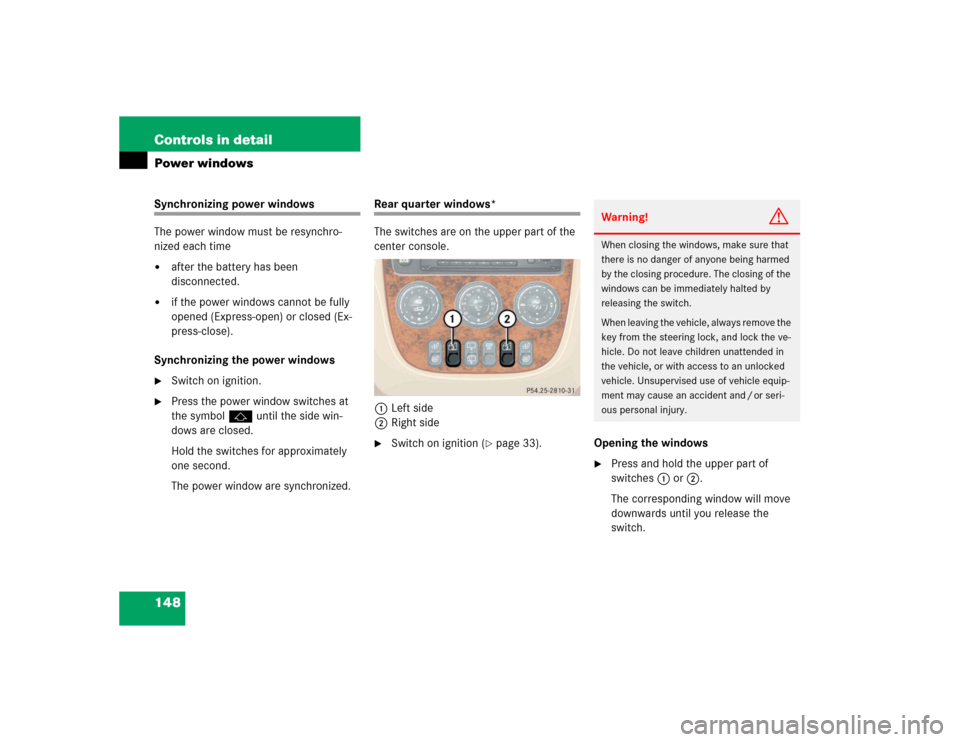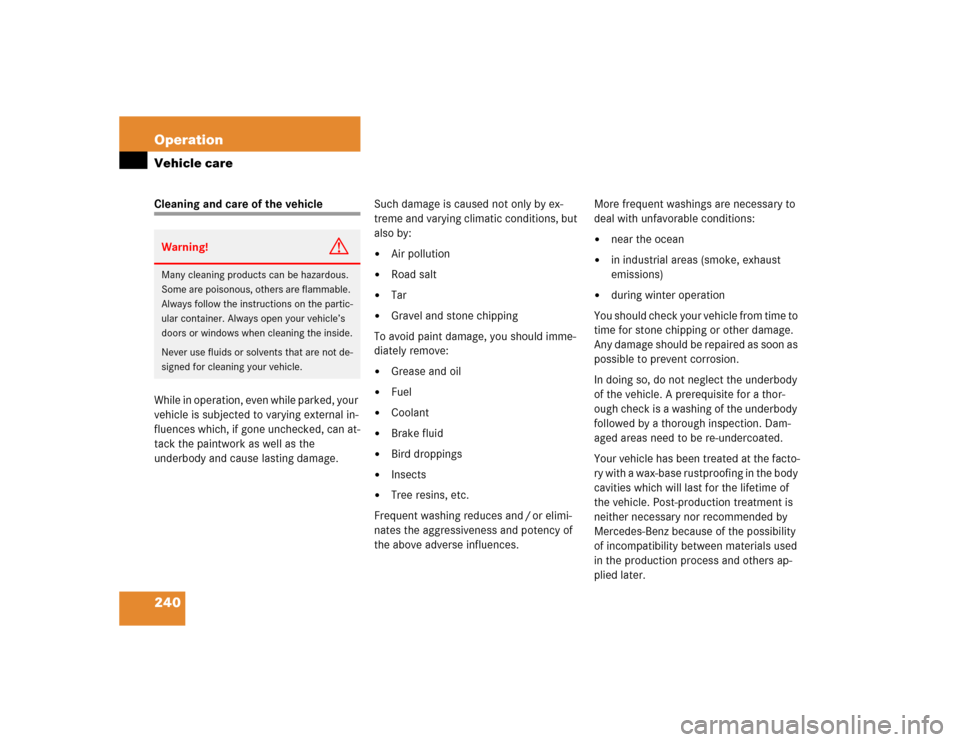Page 150 of 356

148 Controls in detailPower windowsSynchronizing power windows
The power window must be resynchro-
nized each time�
after the battery has been
disconnected.
�
if the power windows cannot be fully
opened (Express-open) or closed (Ex-
press-close).
Synchronizing the power windows
�
Switch on ignition.
�
Press the power window switches at
the symbolj until the side win-
dows are closed.
Hold the switches for approximately
one second.
The power window are synchronized.
Rear quarter windows*
The switches are on the upper part of the
center console.
1Left side
2Right side�
Switch on ignition (
�page 33).Opening the windows
�
Press and hold the upper part of
switches1 or2.
The corresponding window will move
downwards until you release the
switch.Warning!
G
When closing the windows, make sure that
there is no danger of anyone being harmed
by the closing procedure. The closing of the
windows can be immediately halted by
releasing the switch.
When leaving the vehicle, always remove the
key from the steering lock, and lock the ve-
hicle. Do not leave children unattended in
the vehicle, or with access to an unlocked
vehicle. Unsupervised use of vehicle equip-
ment may cause an accident and / or seri-
ous personal injury.
Page 151 of 356
149 Controls in detail
Power windows
Closing the windows�
Press and hold the lower part of
switches1 or2.
The corresponding window will move
upwards until you release the switch.
Page 207 of 356

205 Operation
Driving instructions
Special driving features for off-road
driving
The following driving features are available
for specific kind of operation:�
LOW RANGE mode (
�page 127)
�
LOW RANGE – ABS (
�page 77)
�
LOW RANGE – 4-ETS (
�page 80)
�
LOW RANGE – ESP (
�page 81)
Off-road driving rules
Engage the LOW RANGE mode before driv-
ing under off-road conditions
(
�page 127).
Fasten items being carried as securely as
possible (
�page 160).Checklist before off-road driving
Engine oil level
�
Check the engine oil level
(�page 224). The display
OIL i.O
must appear via display in the speed-
ometer.
Only then can the vehicle obtain a trou-
ble-free oil supply, even on steep gradi-
ents.
iWe recommend keeping doors, liftgate,
windows, and tilt / sliding sunroof*
closed whenever driving in off-road
mode.
!Observe the following during off-road
driving:�
Adjust vehicle speed to condition of
terrain. The more uneven, rutty and
steeper the terrain, the lower the
speed should be.
�
Watch out for obstacles, such as
rocks, holes, tree stumps and ruts.
�
Be especially careful when driving
in unknown territory. It may be nec-
essary to get out of the vehicle and
scout the path you intend to take.
�
Before driving through water, deter-
mine is depth.
�
Do not stop vehicle while immersed
in water, and do not shut off the
engine.
�
In sandy soil, please drive at a
steady speed as allowed by condi-
tions. This helps overcome the vehi-
cle rolling resistance and reduces
the likelihood of the vehicle sinking
into the ground.
�
Do not initiate jumps with the vehi-
cle. It interrupts the forward mo-
mentum of the vehicle.
�
Always drive onto slopes with the
the engine running and the vehicle
in gear.
Page 217 of 356

215 Operation
Driving instructions
�
If the transmission hunts between
gears on inclines, manually shift to a
lower gear (select 4, 3, 2 or 1).
A lower gear and reduction of speed re-
duces the chance of engine overload-
ing and / or overheating.
�
On very steep inclines, not manageable
with gear selector lever in position1,
switch transfer case to LOW RANGE
mode (
�page 127).
�
When going down a long hill, shift into
a lower gear and use the engine’s brak-
ing effect.
Avoid riding the brakes, thus overheat-
ing the vehicle and trailer brakes.
�
If the engine coolant rises to an ex-
tremely high temperature (coolant tem-
perature needle approaching the red
zone) when the air conditioning is on,
turn off the air conditioning system.
Engine coolant heat can be additionally
vented by opening the windows,
switching the climate control fan speed
to high and setting the temperature
control to the maximum hot position.
�
Extreme care must be exercised since
your vehicle with a trailer will require
additional passing distance ahead than
when driving without a trailer.
Because your vehicle and trailer is
longer than your vehicle alone, you will
also need to go much farther ahead of
the passed vehicle before you can re-
turn to your lane.
Passenger compartmentWarning!
G
Always fasten items being carried as secure-
ly as possible.
In an accident, during hard braking or sud-
den maneuvers, loose items will be thrown
around inside the vehicle, and cause injury
to vehicle occupants unless the items are
securely fastened in the vehicle.
The rear cargo compartment is the preferred
place to carry objects. Always use the parti-
tion net when transporting cargo. Partition
net cannot secure hard or heavy objects. Al-
ways fasten items being carried as securely
as possible using the cargo tie-down rings in
the cargo floor area and fastening materials.
Page 242 of 356

240 OperationVehicle careCleaning and care of the vehicle
While in operation, even while parked, your
vehicle is subjected to varying external in-
fluences which, if gone unchecked, can at-
tack the paintwork as well as the
underbody and cause lasting damage.Such damage is caused not only by ex-
treme and varying climatic conditions, but
also by:
�
Air pollution
�
Road salt
�
Tar
�
Gravel and stone chipping
To avoid paint damage, you should imme-
diately remove:
�
Grease and oil
�
Fuel
�
Coolant
�
Brake fluid
�
Bird droppings
�
Insects
�
Tree resins, etc.
Frequent washing reduces and / or elimi-
nates the aggressiveness and potency of
the above adverse influences.More frequent washings are necessary to
deal with unfavorable conditions:
�
near the ocean
�
in industrial areas (smoke, exhaust
emissions)
�
during winter operation
You should check your vehicle from time to
time for stone chipping or other damage.
Any damage should be repaired as soon as
possible to prevent corrosion.
In doing so, do not neglect the underbody
of the vehicle. A prerequisite for a thor-
ough check is a washing of the underbody
followed by a thorough inspection. Dam-
aged areas need to be re-undercoated.
Your vehicle has been treated at the facto-
ry with a wax-base rustproofing in the body
cavities which will last for the lifetime of
the vehicle. Post-production treatment is
neither necessary nor recommended by
Mercedes-Benz because of the possibility
of incompatibility between materials used
in the production process and others ap-
plied later.
Warning!
G
Many cleaning products can be hazardous.
Some are poisonous, others are flammable.
Always follow the instructions on the partic-
ular container. Always open your vehicle’s
doors or windows when cleaning the inside.
Never use fluids or solvents that are not de-
signed for cleaning your vehicle.
Page 292 of 356
290 Practical hintsBattery
Batteries contain materials that can harm
the environment if disposed of improperly.
Large 12 volt storage batteries contain
lead. Recycling of batteries is the preferred
method of disposal. Many states require
sellers of batteries to accept old batteries
for recycling.
iThe following procedures must be car-
ried out following any interruption of
battery power (e.g. due to reconnec-
tion):�
Set the clock (
�page 119).
�
Set the date in trip computer
(�page 189).
�
Calibrate the compass
(�page 191).
�
Resynchronize the ESP
(�page 252).
�
Resynchronize side power windows
(�page 148).
�
Resynchronize tilt / sliding
sunroof*(
�page 152).
Page 335 of 356

333 Index
Cleaning
Cup holder 244
Gear selector lever 244
Hard plastic trim items 244
Headlamps 133
Headliner 244
Instrument cluster 244
Leather upholstery 245
Light alloy wheels 244
MB Tex upholstery 245
Plastic and rubber parts 245
Seat belts 244
Steering wheel 244
Windows 243
Windshield 51
Wiper blades 243
Clock 26, 119
Closing
Glove box 167
Hood 223
Liftgate 92
Power tilt/sliding sunroof* 271
Rear quarter windows* 149
Side windows 147
Tilt/sliding sunroof* 150Closing tilt/sliding sunroof*
In an emergency 271
Cockpit 22, 323
Combination switch
High beam flasher 50
Turn signals 50
Windshield wipers 51
Compass 190
Calibrating 191
Setting compass zone 191
Compass zone 191
Consumer information 320
Control and operation of radio
transmitters 216
Coolant 227, 316
Adding 228
Anticorrosion/antifreeze
quantity 316
Checking level 227
Indicator lamp 256
Temperature 218
Temperature gauge 118Coolant level
Checking 227
Crossing obstacles 209
Cruise control 153, 323
Canceling 154
Driving downhill 154
Driving uphill 154
Fine adjustment 155
LOW RANGE mode 155
Saving current speed 154
Setting speeds 155
Cruise control lever 153
Cup holder 169
Cleaning 244
In front seat armrest 170
In instrument panel 169
In rear center console 170
Customer Assistance Center (CAC) 323
Page 343 of 356

341 Index
MCS
Modular Control System 325
Mechanical key 268
Memory function 105, 325
Memory function* 106
Recalling positions from
memory 106
Mirrors
Activating exterior mirror parking
position 129
Adjusting 41
Automatic antiglare for rear view
mirror 128
Exterior rear view mirror 41
Storing exterior rear view mirror
parking position 106
MON 220
MON (Motor Octane Number) 325
Multifunction display 325
N
Night security illumination 109
Deactivation temporarily 110O
Occupant safety 58
Children and airbags 60
Children in the vehicle 67
Fastening the seat belt 43
Infant and child restraint systems 68
LATCH child seat mounts 73
Seat belts 43, 62
Odometer display 118
Odometer, main 25
Off-road driving
Checklist 205, 210
Crossing obstacles 209
Driving instructions off-road
driving 204
Driving through water 208
Returning 210
Rules 205
Special driving features 205
Steep terrain 206
Oil
Adding 226
Consumption 223
Dipstick 223
Oil dipstick 226
Viscosity 324One-touch gearshifting 121
Canceling gear range limit 121
Downshifting 121
Upshifting 121
Opening
Doors from the inside 90
Fuel filler flap 219
Fuel filler flap manually 269
Glove box 167
Hood 222
Liftgate 89, 91
Liftgate from inside 91
Liftgate from outside 91
Power tilt/sliding sunroof* 271
Rear quarter windows* 148
Side windows 147
Storage compartment in front of
armrest 169
Storage compartment under passenger
seat 168
Tilt/sliding sunroof* 150
Tilt/Sliding sunroof* in an
emergency 271
Windows 147